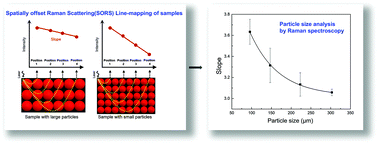Spatially offset Raman scattering line-mapping as a potential tool for particle size analysis
Abstract
A spatially offset Raman spectroscopy (SORS) line-mapping scheme was explored as a tool for the measurement of particle size. The proposed scheme is based on the fact that photon migration in powder packing varies as a function of the reduced scattering coefficient, which is directly related to the particle size of the sample. It is known that a smaller particle yields a larger reduced scattering coefficient. Therefore, recognition of the particle size-dependent photon migration (distribution) could be a means to determine the sample's particle size and SORS is a versatile tool for this purpose. Peak intensities acquired along the SORS mapping line are expected to decrease with an increase of the offset distance and the descending slope of the peak intensity can be translated into particle size, for example, a greater slope (steeper intensity decrease) for smaller particles yielding a narrower (denser) photon distribution. For the study, low-density polyethylene (LDPE) and middle-density PE (MDPE) powders with four particle sizes were measured. In each case, the slope of intensity decrease became less steep with the increase of particle size due to the broader photon distribution. A comparative analysis of LDPE and MDPE spectra found that the slope was steeper in the measurement of MDPE powder since the photon distribution was narrower owing to the high particle density. Together, these findings suggest that the proposed scheme is potentially expandable to measure particle sizes of samples with relevant prior calibration and provide useful information on sample composition also for chemical analysis.

- This article is part of the themed collection: 150th Anniversary Collection: Raman Spectroscopy and SERS


 Please wait while we load your content...
Please wait while we load your content...